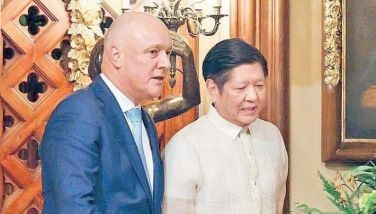The heroic voyage of Vasco Núñez de Balboa
MANILA, Philippines - On the 25th of September 1513, the Spanish explorer Vasco Núñez de Balboa, with only 190 men, a small two-masted ship and 10 indigenous canoes, caught sight of the new ocean from a summit on the Isthmus of Panama. He would call it the “South Sea†after the route taken by explorers to reach the said sea.
At that moment, Núñez de Balboa unwittingly opened a new chapter in the history of mankind. In 1513, eight years before Magellan reached the Philippines, the Spaniards entered into a new geographic domain, completely unknown to the Old World of the moment. Across that “South Sea†they had Cathay and Cipango (the former China and Japan), the Philippines and the Pacific Islands. In 1520 Ferdinand Magellan renamed the “South Sea†the Pacific Ocean, apparently for its calm waters.
Today, Vice President Jejomar Binay will honor the opening ceremony of the exhibit “The Pacific: Spain and the Discovery of the South Sea†in the National Museum, which will remain open until the end of January 2014. This exhibit, the first in Asia to commemorate this milestone, mirrors the ones that have taken place in July and September in the Spanish cities of Trujillo and Sevilla. From here it will travel to other countries in the region.
This is a particularly important commemoration, not only for Spain or Panama but for the entire American continent, the rest of Europe as well as Asia and the Pacific. Since that discovery, Americans, Europeans, and the inhabitants of Asia and the Pacific region commenced a long term relationship and started a hybridization process which has had a great impact in the day to day life of people all over the world. The impact has not only been commercial but also social, cultural and, in general, of civilization. Initiatives of our time like APEC, or the Latin American Pacific Alliance, echo the network of bonds and interests that were started 500 years ago and that make of the Pacific the most important socio-economic hub on the planet at present.
Of all the contacts between peoples that the discovery of the Pacific Ocean gave way to, I would like to highlight one of the most enduring ones, the so-called “Manila Galleon,†the maritime link which would connect for more than two centuries Manila to Sevilla and Cadiz in Spain, through a short land haul of the cargo from Acapulco to Veracruz, main ports in the then Viceroyalty of Nueva España. With the proclamation of the independence of Mexico, it was no longer continued. The last galleon of the 108 ships that crossed the Pacific Ocean reached Acapulco in 1811 and was unable to unload its cargo because of the Mexican insurrection.
The “Manila Galleon†has represented much more than a major trade route between the Philippines, many other countries in Asia, Latin America and Spain for 250 years, from 1565 to 1815. The galleon, which traveled each time 8,200 miles across the Pacific Ocean, put in contact the cultures and way of life of more than 35 countries during much of the Spanish colonial period of the Philippines. Many objects were traded such as silk, porcelain, lacquer work, carpets, spices, mother of pearl, among many other goods from China, Japan, India, the other South East Asian countries and the Philippines. America and Europe would, on their side, reciprocate sending silver, fabrics, wine, etc. to Asia. However, it was not only merchandise that the galleon would load and unload in Manila, but also the thinking and ideas contained in the books that came from Europe and America and which would enlighten the minds of the Filipino students in the Schools and Universities that the Spaniards established in the Philippines, the oldest ones in all of Asia. New forms of art were also brought about as a result of the trade: the Philippine-Spanish ivory pieces carved by the Sino-Filipino craftsmen in Manila are found in all the major churches and monasteries in Spain and in other places in Europe. Countries involved in the galleon trade were also transformed socially and economically. Since 1679, all the galleons were required by a Royal Decree to be constructed in the Philippines, giving way to the extensive knowledge that today we still see in the shipyard industry of the country. In Cavite and Zamboanga, along with the ship building of the galleons, we witnessed the birth of a creole Spanish language, Chabacano. Furthermore, the agriculture of Europe, America and the Philippines underwent a revolution thanks to the trees and plants that were transported in the cargo holds of the ships and introduced in our fields and tables.
In two years time, in 2015, we will be celebrating the bicentennial of the end of the galleon trade, curiously the same year that Manila will host the APEC Summit meeting that will bring together many of the countries that were involved in the galleons voyages. It is therefore most opportune to learn that there is an ongoing initiative for the creation of a Galleon Museum in Manila and Spain is more than ready to help in this endeavor.
However, commemorations should serve the purpose of more than just looking towards the past, they should also offer an opportunity to underline the current and future interest of Spain in strengthening further its enduring ties with the Asian and Pacific regions, in particular with the Philippines. This commemoration, of 500 years of the discovery of the “South Sea,†should therefore showcase our will to be an active part of the present day to day life of the Filipinos of today. The Philippines, which continues to be one of our main Asian partners in international relations and multilateral fora, is our only priority development partner in the region and now becoming a prime destination for our exports which have grown 40 percent in 2012. Along with the more than thirty thousand Filipinos that travel to Spain every year and the more than fifteen thousand Spaniards that come to this country, the exchanges and contacts between our universities and the renewed interest in the Spanish language, are all clear signs of the good state of our relations. For Spain, the discovery of the “South Sea†was just a first step in its long journey together with the Philippines towards the construction of the global world of today.
- Latest
- Trending


























